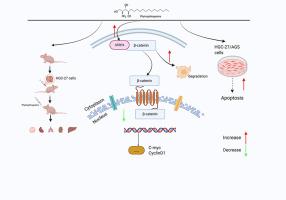植物鞘氨醇通过SFRP4/β-Catenin轴介导的Wnt信号通路抑制胃癌
IF 5.4
2区 医学
Q1 BIOCHEMISTRY & MOLECULAR BIOLOGY
引用次数: 0
摘要
中医(TCM)历来被用于治疗各种疾病,包括恶性肿瘤,如癌症。植物鞘磷脂(Phytosphingosine, PHS)是一种具有抗肿瘤活性的天然化合物,近年来在肿瘤学研究中受到越来越多的关注。目的:系统探讨小灵通在GC中的药理作用及分子机制。方法:通过转录组测序鉴定靶向分泌卷曲相关蛋白4 (SFRP4)的小分子,并使用细胞热移测定(CETSA)进行验证。为了研究PHS的药理作用,我们采用了Transwell侵袭实验、菌落形成实验、异种移植肿瘤模型和基于流式细胞术的细胞凋亡检测。通过免疫共沉淀(Co-IP)、免疫组织化学(IHC)和免疫印迹(Western blotting)探索分子机制。结果:结果表明,PHS通过双重机制抑制GC的进展:(1)通过剂量依赖性地增加Bax/Bcl-2比值直接诱导细胞凋亡;(2)更重要的是,PHS通过抑制分泌的SFRP4磷酸化,促进β-catenin泛素-蛋白酶体降解,实现对Wnt信号通路的关键调控。Western blot和小鼠模型证实Wnt信号成分(β-catenin, Cyclin D1, c-Myc)的表达降低,肿瘤生长明显抑制。结论:这些发现揭示了SFRP4-Wnt轴是小灵通的中心靶点,为其分子作用提供了新的见解,并突出了其作为传统医学治疗策略的潜力,对靶向wnt驱动的胃癌具有临床意义。本文章由计算机程序翻译,如有差异,请以英文原文为准。

Phytosphingosine suppresses gastric cancer through SFRP4/β-catenin axis-mediated Wnt signaling pathway inhibition
Introduction
Traditional Chinese Medicine (TCM) has historically been employed in the treatment of various diseases, including malignancies such as cancer. Phytosphingosine (PHS), a bioactive natural compound with antitumor properties, has attracted increasing attention in recent oncological studies.
Objectives
This study systematically investigates the pharmacological effects and molecular mechanisms of PHS in GC.
Methods
The small molecule targeting Secreted Frizzled-Related Protein 4 (SFRP4), identified through transcriptome sequencing, was validated using Cellular Thermal Shift Assay (CETSA). To investigate the pharmacological effects of PHS, we employed Transwell invasion assays, colony formation assays, xenograft tumor models, and flow cytometry-based apoptosis detection. Molecular mechanisms were explored via co-immunoprecipitation (Co-IP), immunohistochemistry (IHC), and Western blotting.
Result
The results demonstrate that PHS suppresses GC progression by dual mechanisms: (1) directly inducing apoptosis via a dose-dependent increase in the Bax/Bcl-2 ratio and (2) more importantly, PHS achieves pivotal regulation of the Wnt signaling pathway through suppression of secreted SFRP4 phosphorylation, which promotes β-catenin ubiquitin-proteasomal degradation. Western blot and murine models confirmed reduced expression of Wnt signaling components (β-catenin, Cyclin D1, c-Myc) and significant tumor growth inhibition.
Conclusions
These findings reveal the SFRP4-Wnt axis as a central target for PHS, offering novel insights into its molecular action and highlighting its potential as a therapeutic strategy derived from traditional medicine, with clinical implications for targeting Wnt-driven gastric carcinogenesis.
求助全文
通过发布文献求助,成功后即可免费获取论文全文。
去求助
来源期刊
CiteScore
7.70
自引率
3.90%
发文量
410
审稿时长
36 days
期刊介绍:
Chemico-Biological Interactions publishes research reports and review articles that examine the molecular, cellular, and/or biochemical basis of toxicologically relevant outcomes. Special emphasis is placed on toxicological mechanisms associated with interactions between chemicals and biological systems. Outcomes may include all traditional endpoints caused by synthetic or naturally occurring chemicals, both in vivo and in vitro. Endpoints of interest include, but are not limited to carcinogenesis, mutagenesis, respiratory toxicology, neurotoxicology, reproductive and developmental toxicology, and immunotoxicology.

 求助内容:
求助内容: 应助结果提醒方式:
应助结果提醒方式:


